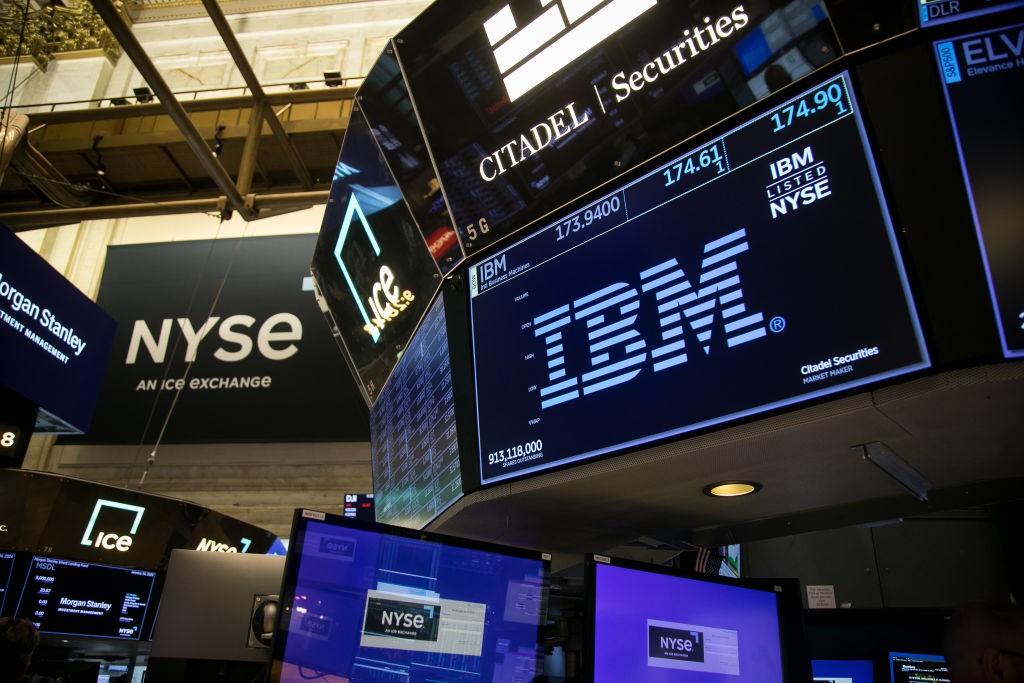IBM Stock Takes a Rare Tumble After Earnings: What to Know
IBM stock is chipping away at its impressive year-to-date return after a Q3 revenue miss, but one analyst isn't worried. Here's why.


International Business Machines (IBM) stock is notably lower in Thursday's session after the technology giant topped third-quarter profit expectations but came up short of revenue estimates.
In the three months ended September 30, IBM's revenue increased 1.5% year over year to $15 billion, driven by a 9.7% jump in sales in its software segment to $6.5 billion. Its earnings per share (EPS) were up 4.6% from the year-ago period to $2.30.
The results were mixed compared with analysts' expectations. Wall Street was anticipating revenue of $15.1 billion and earnings of $2.23 per share, according to CNBC.
From just $107.88 $24.99 for Kiplinger Personal Finance
Become a smarter, better informed investor. Subscribe from just $107.88 $24.99, plus get up to 4 Special Issues

Sign up for Kiplinger’s Free Newsletters
Profit and prosper with the best of expert advice on investing, taxes, retirement, personal finance and more - straight to your e-mail.
Profit and prosper with the best of expert advice - straight to your e-mail.
"Our third-quarter performance was led by double-digit growth in Software, including a re-acceleration in Red Hat," said IBM CEO Arvind Krishna in a statement. "We continue to see great momentum in artificial intelligence as our models are trusted, fit-for-purpose, and lower cost, with performance leadership. Our generative AI book of business now stands at more than $3 billion, up more than $1 billion quarter to quarter."
For the fourth quarter, IBM said it expects revenue growth consistent with the third quarter. The company also reiterated its full-year forecast for more than $12 billion in free cash flow.
Free cash flow is important to investors because companies "can do a number of useful things with it, such as pay dividends, buy back its stock, acquire other companies, expand its business and knock out its debts," writes Kiplinger contributor Will Ashworth on the importance of good cash flow.
And for IBM, specifically, some of its free cash flow is used to consistently pay and grow its dividend. Indeed, IBM is one of the best dividend stocks for dividend growth, having increased its payout annually for the past 29 years.
Is IBM stock a buy, sell or hold?
Even with Thursday's post-earnings slump, IBM has been one of the best Dow Jones stocks in 2024, up 46% for the year to date on a total return basis (price change plus dividends). But Wall Street doesn't think there's much more room to run.
According to S&P Global Market Intelligence, the average analyst target price for IBM stock is $214.85, which represents a discount to current levels. Additionally, the consensus recommendation is a Hold.
Not everyone is on the sidelines, though. Financial services firm Stifel is one of the more bullish outfits on the blue chip stock, as evidenced by its Buy rating and $246 price target.
"IBM has re-rated higher relative to S&P 500 reflecting improving execution, free cash flow growth and the company's defensive characteristics," says Stifel analyst David Grossman. “We believe the risk/reward remains attractive as the stock could continue to re-rate further with consistent software revenue growth (Red Hat, ELA cycle, and HashiCorp acquisition), the upcoming mainframe cycle and continued free cash flow growth."
Related Content
- Earnings Calendar and Analysis for This Week
- Analysts' Top S&P 500 Stocks to Buy Now
- Is Tesla Stock a Buy After Blowout Earnings?
Profit and prosper with the best of Kiplinger's advice on investing, taxes, retirement, personal finance and much more. Delivered daily. Enter your email in the box and click Sign Me Up.

Joey Solitro is a freelance financial journalist at Kiplinger with more than a decade of experience. A longtime equity analyst, Joey has covered a range of industries for media outlets including The Motley Fool, Seeking Alpha, Market Realist, and TipRanks. Joey holds a bachelor's degree in business administration.
-
 QUIZ: What Type Of Retirement Saver Are You?
QUIZ: What Type Of Retirement Saver Are You?Quiz What is your retirement savings style? Find out with this quick quiz.
-
 Meet the World's Unluckiest — and Entitled — Porch Pirate
Meet the World's Unluckiest — and Entitled — Porch PirateThis teen swiped a booby-trapped package that showered him with glitter, and then he hurt his wrist while fleeing. This is why no lawyer will represent him.
-
 Smart Business: How Community Engagement Can Help Fuel Growth
Smart Business: How Community Engagement Can Help Fuel GrowthAs a financial professional, you can strengthen your brand while making a difference in your community. See how these pros turned community spirit into growth.
-
 Meet the World's Unluckiest — Not to Mention Entitled — Porch Pirate
Meet the World's Unluckiest — Not to Mention Entitled — Porch PirateThis teen swiped a booby-trapped package that showered him with glitter, and then he hurt his wrist while fleeing. This is why no lawyer will represent him.
-
 Smart Business: How Community Engagement Can Help Fuel Growth
Smart Business: How Community Engagement Can Help Fuel GrowthAs a financial professional, you can strengthen your brand while making a difference in your community. See how these pros turned community spirit into growth.
-
 In 2026, the Human Touch Will Be the Differentiator for Financial Advisers
In 2026, the Human Touch Will Be the Differentiator for Financial AdvisersAdvisers who leverage innovative technology to streamline tasks and combat a talent shortage can then prioritize the irreplaceable human touch and empathy.
-
 How Financial Advisers Can Deliver a True Family Office Experience
How Financial Advisers Can Deliver a True Family Office ExperienceThe family office model is no longer just for the ultra-wealthy. Advisory firms will need to ensure they have the talent and the tech to serve their clients.
-
 Stocks Slip to Start Fed Week: Stock Market Today
Stocks Slip to Start Fed Week: Stock Market TodayWhile a rate cut is widely expected this week, uncertainty is building around the Fed's future plans for monetary policy.
-
 December Fed Meeting: Live Updates and Commentary
December Fed Meeting: Live Updates and CommentaryThe December Fed meeting is one of the last key economic events of 2025, with Wall Street closely watching what Chair Powell & Co. will do about interest rates.
-
 Why Investors Shouldn't Romanticize Bitcoin, From a Financial Planner
Why Investors Shouldn't Romanticize Bitcoin, From a Financial PlannerInvestors should treat bitcoin as the high-risk asset it is. A look at the data indicates a small portfolio allocation for most investors would be the safest.
-
 I'm a Financial Pro Focused on Federal Benefits: These Are the 2 Questions I Answer a Lot
I'm a Financial Pro Focused on Federal Benefits: These Are the 2 Questions I Answer a LotMany federal employees ask about rolling a TSP into an IRA and parsing options for survivor benefits, both especially critical topics.